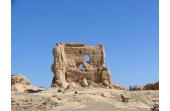Jiaohe Ruin
- Things to do
-
- Photo(17)
- Tips&article(2)
- Make it Happen
- Map
-
loading...
Feature
- Big ancient ruined city in Xinjiang and one of the best preserved cities of its time in China.
- A highlight of travel to the interesting and beautiful Turpan area.
- Some big structures remain such as a ruined tower and one of China’s oldest Buddhist stupas that is about 1,400 years old.
- Like Gaochang, the city was abandoned about the year 1,400.
- There is a museum about the Cheshi or Gushi people near the ruins.
Overview
Most tourists think that the ruins of the ancient city of Jiaohe are Turpan’s best travel highlight. It is more intact than the nearby ruins of Gaochang, although the cities were built and fell into disuse at about the same times. The people who lived in the area around Gaochang used it as a source for fertilizer, and farmers leveled it for fields.
They also purposely destroyed artwork and manuscripts that they found there, fearing the Moslem leaders’ injunction against keeping idols and false books. The local people found it more difficult to cultivate Jiaohe. There is no surface water or karez irrigating the top of the islet. The islet is surrounded by two canyons and steep cliffs.
This made access to the city more difficult, and though farmers cultivated in the canyons around it, they couldn’t easily cultivate in the city or carry materials away. This may be why Jiaohe is better preserved than Gaochang. The islet is about 300 meters or 1,000 feet wide at its widest point and 1.
6 kilometers or a mile long, and it was called Jiaohe because in Chinese Jiaohe (交河) means “rivers meeting.” It is one of the best preserved ruins of its ancient era in China, so it will probably be the highlight of a trip to Turpan.
The islet is between canyons that are about 20 to 30 meters or about 65 to 100 feet deep. The islet is shaped like a dagger with its tip pointing at the southeast. The people constructed the city out of earth. They excavated the ground to leave standing structures or dug rooms underground, and they built with dried bricks.
There was a long main street that went down the center of the islet that divided the city into two parts. The western part was for common people, and the rulers lived in the east. The northwestern part of the city had a Buddhist monastery and stupas. There was also a cemetery and an underground temple at the far northwestern end.
The city is said to have only had two gates. One was at the southwestern corner and one was in the east. It is unusual for a city of this size to have only two gates. There may be vestiges of a third gate. On the northwest side, there is a Buddhist monastery and a big tower that is one of the biggest remaining ruins.
History
In tombs near Jiaohe that date to 300 BC, the remains of Caucasians were recently found. So some historians suggest that the first inhabitants of the islet might have been Caucasians. The Gushi people who were Caucasians lived on the islet in a town called Cheshi. About 100 BC, the Han Dynasty began trade with western countries.
The Han wanted to control the trade and to protect it from rival empires. The Cheshi people came under the control of the Han Empire about 60 BC. Perhaps 1,000 troops were stationed there after that. Then, the Han Dynasty lost control of the area, and the Han Empire collapsed. Other kingdoms controlled the area until the Tang Dynasty.
In 640, a Tang general conquered the area including Gaochang. Most of the construction that remains is from the Tang Dynasty era. It is said that 7,000 people lived in Jiaohe in the 8th century.
The Tang Empire was defeated about the year 856. Around that time, a group of Uighurs fled to the area after another people called the Kyrgyz conquered their main territory around Mongolia far to the northeast. The Uighurs took control of northern and western Xinjiang. About the year 1209, the Uighurs submitted to Genghis Khan of the expanding Mongol Empire.
Then about the middle of the 14th century, the Mongol Empire collapsed. The resulting disruption of trade, warfare, and perhaps also a lack of water and a drier and colder climate associated with the Little Ice Age caused people to abandon the former fortress city.
Touring Activities
- Learn about the successive civilizations of people who lived there.
- Appreciate the stark beauty of the ruined city and the surrounding desert canyons and hills.
- Go to the Cheshi Museum to learn about the Cheshi people.
- Go to the nearby Turpan Museum to see mummies, Manichean art, and Silk Road artifacts.
Travel Essentials
- Location: Jiaohe Ancient City is only about 10 kilometers or 6.2 miles east of the center of Turpan. If you are coming from the Turpan Karez Museum, it is even closer because the Karez Museum (坎儿井博物馆) is about three kilometers or 1.5 miles west of the center of Turpan.
- When to go: the best time to visit is between April and October. If you go
between July and October, you can enjoy the freshly harvested
fruit.
Nearby Attractions
The Turpan region has other interesting historical and archeological sites about 45 kilometers to the east at the Astana Tombs, the Bezeklik Thousand Buddha Caves, and the Gaochang Ruins.
How to Get to there?
Tips & articles
|
|










